
The initial kick-off for getting people in orbit in the first place was to build a fleet of solar-power satellites, using as much non-Earthly mass as possible to save on launch costs. The main source of such mass was Luna, but a sub-industry developed for nudging useful rocks into Earth orbit - a sub-industry which, when the revolution came, fell into the hands of the New Atticans.
A decadish ago was the "Blue Revolution", a collection of uprisings against the various oligarchs. Think along the lines of "3D-printed solar-powered onion-routing ad-hoc mesh-network quadcopters" vs "remote-piloted infantry 'bots controlled by a central authority which no longer needs to pay attention to the demands of the people", as mixed by Cory Doctorow, David Brin, and Charles Stross.
At one point, the revolutionaries in orbit dropped a reasonably-sized rock precisely 1,000 km from the island of La Palma; then another one 900 km, and another one 800 km, etc, making a point to anyone on Earth paying attention that if they really wanted, they could create an Atlantic mega-tsunami that would wipe out most of North America's eastern seaboard, among other places.
A boycott came during the revolution, and New Attica came very, very close to losing because of it. Fortunately for them, they had the incentive to come up with enough recycling techniques and similar improvisations to stretch their supplies long enough for one of their rock-herders to bring a body full of light volatiles and other unavailable necessaries, so that the New Atticans no longer needed to depend on supply from Earth. Or, at least, that's how the New Attican history books tell it - the reality was, as might be guessed, much messier and more complicated.
A decade later, all such efforts have either petered out or been outright crushed...
... save for the orbital habitats, many of whom are now part of the libertarian-themed polity of "New Attica". There are a variety of such habitats, from ISS-like workshacks in LEO, to classic Stanford Torus, to "Millennial Project" giant bubbles, in a variety of orbits. Any group on Earth with access to a fighter jet and 1980's-level missile tech can blow up a New Attican hab; New Attica can drop rocks anywhere on Earth; thus leading to a MAD-based Cold War.
Our Heroes are a dozenish citizens of New Attica, the "Bayesian Nakama", with a long and storied past together. One of their shared goals is to 'live forever or die trying', and due to some covert-ops nudging, are now moving one of their backup plans to their main plan - to get far, far away from Earth-Lunar space before the seemingly inevitable exchange of WMDs. Their destination - a set of asteroids in the Vestoid family, of sufficiently varied types to give them access to all the sorts of resources and manufacturing processes they'll need to be self-sufficient.
Three main ship types - superfreighter, lander, water-carrier.
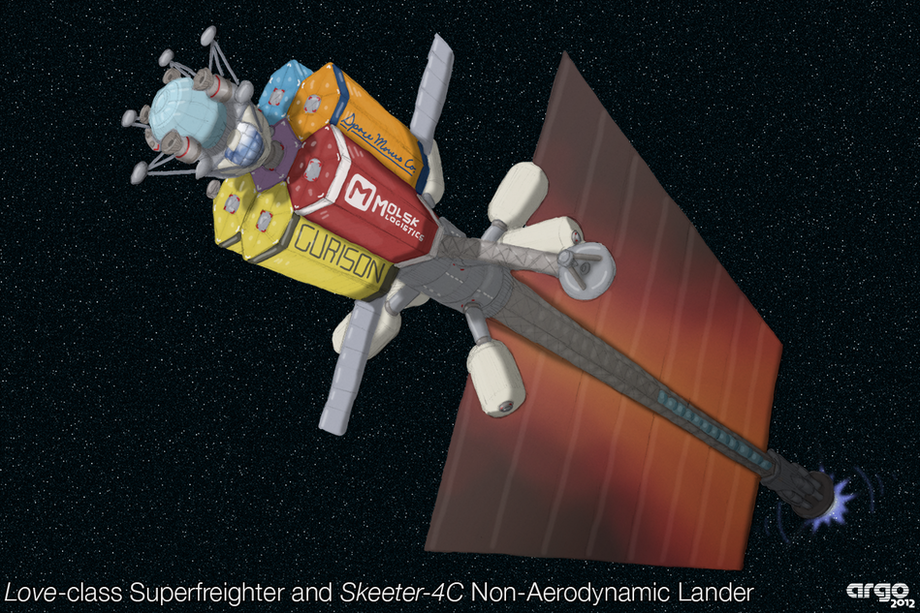
The workhorses, and the current focus of my tinkering. The basic configuration is a standard long boom, roughly so: Attachment for cargo and/or lander | rotating hab | misc equipment | long truss | water tanks | power & propulsion
The main drive takes pions from an antimatter reaction, and uses them to induce sub-critical fission with a Lithium-6 fuel. A maximum delta-vee of about 180 km/sec per year using about 244 tonnes of water propellant, a thrust of 25.6 kiloNewtons, and an Isp of 48,000 seconds. Two radiators, of 6.3 x 12.6 metres each, emit heat at a cherry-red 2700 K.
The 8-person crew section uses an inflatable design, with two counter-rotating sections. Radiation protection is provided by a charged plasma, as well as a storm shelter surrounded by 100 kg/m^2 of polyethylene.
The initial prototype, the Zip, used a propellor-like design, with the two sections each with two lobes 6-stories tall; rotating at 5 rpm to provide 0.6 pseudo-gravity on the outermost levels. However, this design had problems dealing with the strong lateral thrust created by the lander's thruster, and so the subsequent vessels used a centrifuge-like design, with pods inspired by Bigelow's TransHabs gimballed to maintain a consistent internal 'down' direction regardless of thrust.
Two of the more interesting pieces of equipment are an He-Ar nuclear-pumped laser, nominally to use for prospecting (but which just happens to be able to vaporize pieces of an enemy vessel, if necessary, as well as bits of rock to spectro-analyze), and a Wakefield e-beam. The latter is a versatile thing, good not just for boring holes for mining, but also serving as a backup electrothermal rocket drive (which can use just about any mass as propellant).
The inital model used for the first trips, the SF-0 "Zip", had a somewhat different drive configuration than became standard. Once it was rebuilt with the new manufacturing processes available on the V-type asteroids, it was redesignated the SF-1 "Love". The next ships sharing the design were the SF-2 "Unity", SF-3 "Imagination", SF-4 "Napier", SF-5 "Ludolph", and SF-6 "Euler". Most official markings are English written in the Unifon script.
Each hab-module has two pods or 'towers', descending from opposite sides of the hub. For use as mnemonics, the front hab-module's sections are the Green (or Earth) pod and Yellow (or Air) pod; the rear hab-module's sections are the Red (or Fire) pod and Blue (or Water) pod.
The crew section contains the consumables and life support for eight hardy specialists. Paired modules are counter-rotated. Food and atmospheric conditioning is provided by crops that grow without soil but have their roots misted with nutrients daily. A plot 25 meters across provides all the foodstuffs for the year. Waste heat from plant evaporation requires low temperature radiators. A charged plasma sustains a high electrical potential (10 GeV) about the hab unit for protection against most galactic cosmic rays. When a charged particle intercepts this magnetic field, its path curves to avoid the occupants. If a solar storm erupts, the crew must evacuate into a small (8-meter diameter) storm shelter. The shelter is shielded by 100 kg/m2 of polyethylene (12 cm thick), plus water propellant and graphite.
In an emergency, the crew section is easily detachable from the rest of the vessel to serve as a lifeboat.
In general, 8-hour watches: Red Shift (UTC-8, West Australia), Green Shift (UTC-0, London), and Blue Shift (UTC+8, LA). Green and Blue have 3 crew on-shift, Red has 2.
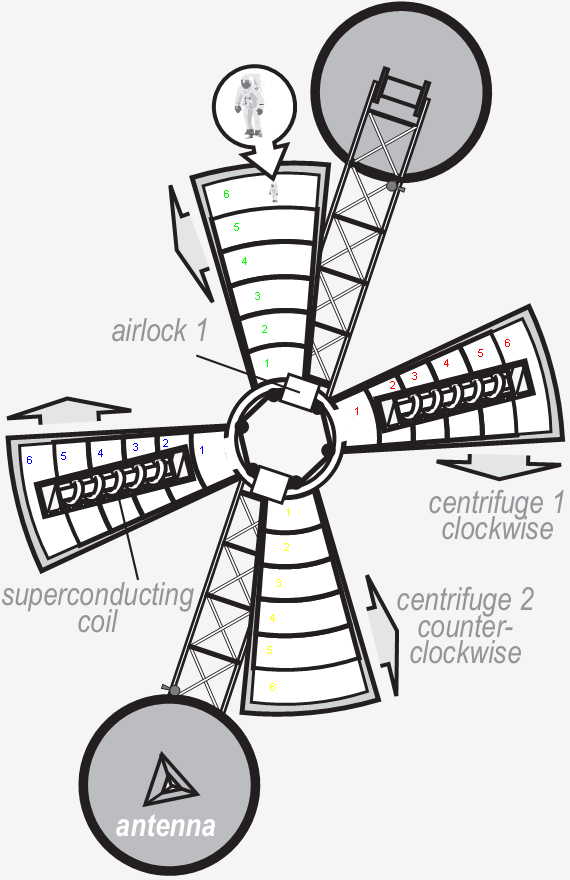

They are housed in inflatable habitation modules, made of Vectran (a "bulletproof" textile).
Unlike the inspirational Pilgrim Observer, the superfreighter doesn't contain three pods on gimbals, but two pods each on two different gimbals, for a total of four.
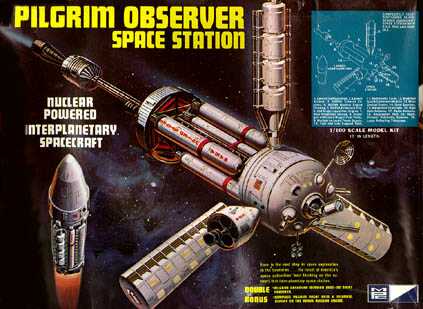


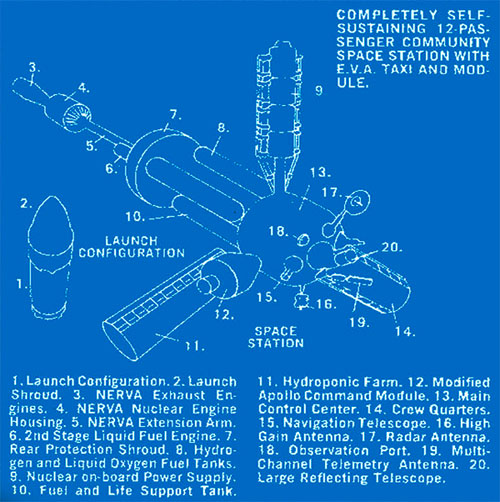


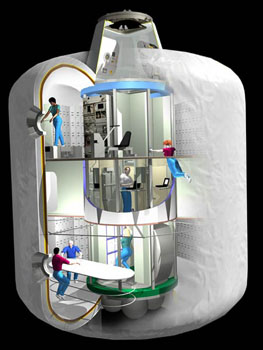
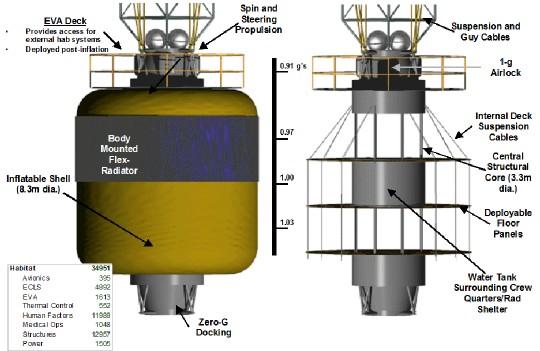
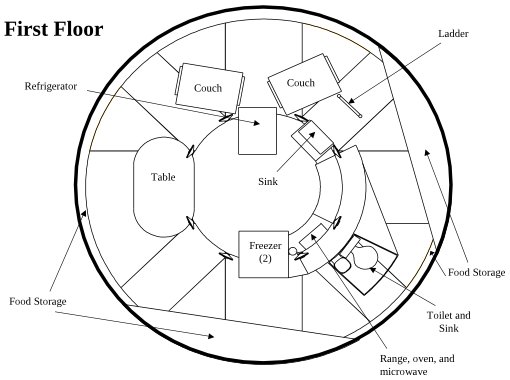


Each tank is an inflatable 40-tonne bag of water with a diameter of 4.25 meters when full.
A typical superfreighter will be set up for 4 to 8 such tanks at any given time.
 |
| N-6Li Microfission thruster |
The minimum explosive yield for fission bombs is about a quarter kiloton. Thus, rockets that fly using atomic explosions, such as Project Orion, require huge shock absorbers. The pulse energy can be brought down to microfission levels by the use of exotic particles. A n-6Li microfission thruster brings the lithium isotope 6Li to spontaneous microfission by interaction with particles with very large reaction cross sections such as ultracold neutrons. No "critical mass" is required. This clean reaction produces only charged particles (T and He), each at about 2 MeV. The system illustrated uses a 5-meter magnetic nozzle to transfer the microexplosion energy to the vehicle. This magnetic impulse transfer is borrowed from the MagOrion concept (combination of Orion and the magnetic sail). A fuel reaction rate of 60 mg/sec yields 3720 MWth. At a pulse repetition rate of one 224 GJ (0.05 kT) detonation each minute, the thrust is 12.8 kN at a 12 ksec specific impulse. A hydraulic fixture oscillates at a tuned frequency to provide a constant acceleration to the spacecraft.
(This thruster receives pions from an antimatter bottle to convert into thrust.)
 |
| Antimatter bottle |
Antimatter fuel can be stored as levitated antihydrogen ice. By illuminating it with UV to drive off the positrons, a bit is electromagnetically extracted and sent to a magnetic bottle. There it is collided with 60 g of heavy metal propellant (9 x 1024 atoms of lead or depleted uranium). Each antiproton annihilates a proton or neutron in the nucleus of a heavy atom. The use of heavy metals helps to suppress neutral pion and gamma ray production by reabsorption within the fissioning nucleus. If regolith is used instead of a heavy metal, the gamma flux is trebled requiring far more cooling. A pulse of 5 µg of fuel (3 x 1018 antiprotons) contains 900 MJ of energy, and at a repetition rate of 0.8 Hz, a power level of 700 MWth is attained. Compared to fusion, antimatter rockets need higher magnetic field strengths: 16 T in the bottle and 50 T in the throat. After 7 ms, this field is relaxed to allow the plasma to escape at 6 keV and 350 atm. These high temperatures and pressures cause higher bremsstrahlung X-ray losses than fusion reactors. Furthermore, the antiproton reaction products are short-lived charged pions and muons, that must be exhausted quickly to prevent an increasing amount of reaction power lost to neutrinos. About a third of the reaction energy is X-rays and neutrons stopped as heat in the shields (partly recoverable in a Brayton cycle), another third escapes as neutrinos. Only the final third is charged fragments directly converted to thrust or electricity in a MHD nozzle.
(This reactor emits waste heat via a magnetocaloric refrigerator.)
Some notes from Phil Eklund:
A useful equation is Newtons of thrust = (mass flow rate in kg/sec) times (exit velocity in m/sec). For this rocket flavor text, and on line 93 of the excel spreadsheet, the thrust is 12.8 kiloNewtons, and the exit velocity is 12 * 9800 = 117,600 m/sec. So the mass flow rate is about 0.11 kg/sec (averaged over a minute), about half of which is ultracold-neutrons-Lithium-6 fuel and the rest is open-cycle water coolant. This is the basic as-designed out of the box microfission rocket. It assumes a leisurely pulse repetition rate of once per minute. It needs a source of exotic particles to work. Suppose that source is the ultracold neutron card, which is +1 thrust. A +1 thrust doubles the thrust (to 25,600 newtons), and doubles the mass flow rate (to 0.22 kg/sec) which means the pulse repetition rate doubles (to twice per minute). The reaction particles are very clean. Because of the hemispherical design of the nozzle only captures half the reactants, the overall efficiency is low, about 20% for the out of the box-design, and even lower for messier reactions. Suppose the source is the antimatter bottle. Now the exotic particles are pions or antiprotons, and the reaction is much messier amat and requires three more radiators. This rocket is no longer fissioning, (unless you assume you are using anti-Lithium-6). So very likely, this combination would dispense with the fission fuel altogether. It may have to use tungsten. Why tungsten? Because the amat reaction is really messy, and the three radiators is pretty generous. Water may have some utility, but really this reaction is so ferocious all the propellent would really have to be a really heavy metal (to contain the pions, and later the gamma rays). So heavy that it would seriously hurt your specific impulse. Its possible that spall-shielding would be needed for the magnetic nozzle magnets, and the spall products would also hurt your specific impulse. But when I designed the card, I decided to ignore the tremendous difficulties of coupling the amat reaction products to the propellant. I decided that somehow water could contain the reaction products, and only 360 MW of the 14880 MWth would need to be rejected by radiators (really generous, almost magic), and if so, it would have a quite lively exit velocity of about 470,000 m/sec. Another useful equation is that thermal Power in watts = half the thrust times the exit velocity. So, since the exit velocity is 4X, the thrust is unchanged, the power must also go up 4X compared to an out-of-the-box micro-fission rocket. This means a pulse repetition rate of four times a minute. Taking thrust = mass flow rate times exit velocity, if the thrust is unchanged and the exit velocity goes up 4X, the mass flow rate goes down by a quarter. For this "antimatter-microfission" rocket, because the antimatter source is so powerful, almost all the exit material is water, and almost nothing is amat products. How much fuel really? You can use the most famous equation in all of physics for this E = mc2. Since the energy required is 14880 Joules every second (again averaging over a minute), then the mass of fuel (half of which is matter and the other half antimatter) is 1.65 X 10^-13 kg/sec. You should double check this calculation as I am doing it in haste.
 |
| Magnetocaloric Refrigerator |
(This radiator receives DC electricity from a multiphase thermoelectric generator.)
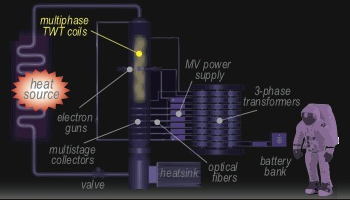 |
| Multiphase thermoelectric generator |
(This generator receives neutrons from an H-6Li Fusor reactor and converts them into pulsed or DC electricity.)
 |
| H-6Li Fusor reactor |
A Farnsworth-Bussard fusor is little more than two charged concentric spheres dangling in a vacuum chamber, producing fusion through inertial electrostatic confinement. Electrons are emitted from an outer shell (the cathode), and directed towards a central grid (the anode). The grid is a hollow sphere of wire mesh, with magnetically-shielded elements so that the electrons do not strike them. Instead, they zip right on through, oscillating back and forth about the center, creating a deep electrostatic trap for the ions of lithium-6 and hydrogen that form the fusion fuel. With a one meter diameter grid and a fuel consumption rate of 7 mg/sec, the fusion power produced is 360 MWth. Half of this energy is bremsstrahlung X-rays, which must be captured in a lithium heat engine. The other half are isotopes of helium (3He and 4He), each at about 8 MeV. Overall efficiency is 36%. Since both products are doubly charged, a decelerating 4 MeV electric field produces two electrons from each, generating an 18 amp current at extremely high voltage. An electron gun using this 4 million-volt energy emits electrons at relativistic speeds. This e-beam can be used to generate electricity using MHD, or may form the input for a free electron laser.
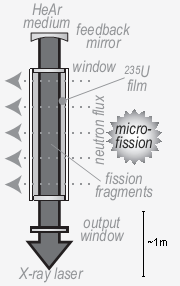 |
| He-Ar nuclear-pumped laser |
A laser of helium and argon gases uses the transmutation of helium-3 in a neutron flux (i.e. the 3He (n,p) D reaction) as the energy source to create inverse populations of energy levels in the gases. These lasing populations surrender their energy as a laser beam by the special optical system illustrated. The neutron flux can be provided by a fast breeder reactor, or a curium microfission bomb. The He-Ar lazing gases are contained in a battery of rods surrounding each shot. The output beam wavelength is in the X-ray range, which has a low beam divergence and a high energy per photon.
(This laser requires the output of any of the three reactors.)
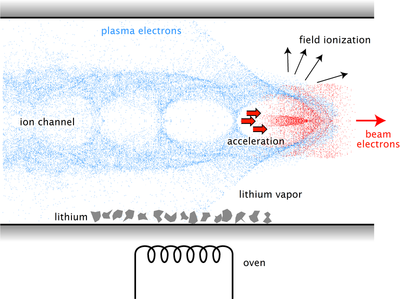
An e-beam (beam of electrons) is a versatile tool. It can bore holes in solid rock (mining), impart velocity to reaction mass (rocketry), remove material in a computer numerical control cutter (finished part fabrication), or act as a laser initiator (free electron laser). A wakefield electron accelerator uses a brief (femtosecond) laser pulse to strip electrons from gas atoms and to shove them ahead. Other electrons entering the electron-depleted zone create a repulsive electrostatic force. The initial tight grouping of electrons effectively surf on the electrostatic wave. Wakefield accelerators a few meters long exhibit the same acceleration as a conventional rf accelerator kilometers in length. In a million-volt-plus electron beam the electrons are approaching lightspeed, so the term relativistic electron beam is appropriate. The wakefield can be used as an electrothermal rocket similar in principle to the arcjet, but far less discriminating in its choice of propellant.
(This e-beam requires 60MWe of pulsed electricity from the multiphase thermoelectric generator.)
Primary job is to move stuff from world surfaces to the orbitng superfreighter and back. Secondary job is to use a Kuck mosquito to mine water, or a scoop to collect and compress atmosphere. Main drive is based on a H-B fusion reciprocator, which compression-heats plasmoids to 300 keV, thrusts with a force of 3.2 megaNewtons, and has an Isp of 460 seconds.
To accelerate 9.7 km/sec, enough to get from Earth's surface to LEO, the lander would need to use up 300 tonnes of water propellant. Mars orbit, at 4.1 km/sec, only needs 60 tonnes; Lunar orbit, 1.6 km/sec, 17 tonnes; and Ceres orbit, 320 m/s, just 3 tonnes. In fact, the lander's drive would only need 13 tonnes of water to push both lander and superfreighter from Ceres' surface to orbit around it - and even less for smaller asteroids.
Almost entirely to annoy bureaucrats, the builders give the landers absurd serial numbers - 2^79641170620168673833 and 3^50247984153525417450, Skewes' number (e^e^e^79), Alef-theta, Moser, Graham's number, a Busy Beaver number, the Avogadro, etc.
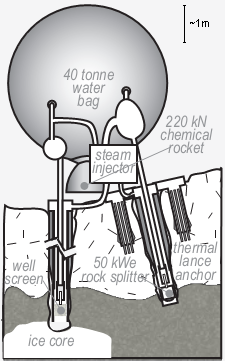 |
| Kuck mosquito |
As icy dormant comets or D-type asteroids are warmed by the sun, they accumulate an outer anhydrous slag layer. An in-situ mining robonaut called the Kuck mosquito is designed to drill through this layer, inject steam, and pump out the water in the core. Some of the water is electrolyzed for fuel for a small H2-O2 chemical engine. To gain a secure foothold, thermal lances melt into the substrate. The targeted bodies must have a cometary matrix of not less than 30% ice. There is a danger of catastrophic fracture of the subsurface mantle layer due to the tensile forces generated by the pressurization.
(This drive receives plasma jets from a reciprocating plasmoid reactor, and converts them into thrust.)
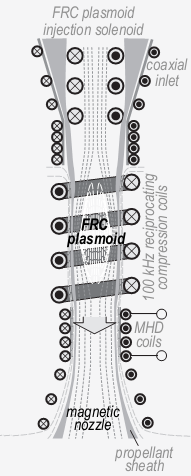 |
| H-B Fusion Reciprocating Plasmoid reactor |
The operation of this fusion engine is comparable to that of an internal combustion engine. The fuel to be combusted is a 25 mg pellet of decaborane (H14B10), a solid at room temperature. This is magnetically converted into a hydrogen-boron plasmoid in a field-reversed configuration (FRC), and injected into a compression/burn chamber. The compression stroke is driven by a piston sheath coupled to a 100 kHz axial magnetic field. This stroke ignites the plasmoid at 300 keV. The sheath plasma forming the piston is lithium, water, or scooped atmosphere propellant. After being superheated, both the fusion products and the sheath propellant are expanded for thrust or energy in a magnetic nozzle. Electrical energy for the compression is picked up via MHD coils in the exhaust. The high energy density, direct propellant coupling, magnetic insulation, and low fusion gain allow for a vastly lighter engine than other magnetically-confined fusion systems such as spherical Tokamaks. With open-cycle cooling and an air scoop, the thrust to weight ratio can be above unity, allowing a ramjet version to enter orbit from the Earth’s surface. Although the H-B reaction is aneutronic, collisions between the ions and electrons lose half the energy to bremsstrahlung X-rays. The sheath, acting as open-cycle coolant, intercepts many of these X-rays, allowing a thermal efficiency of 85%. At 100 kHz and 2.5 kg/sec, 3 GWth is generated with an overall efficiency of 65%.
 |
| Atmospheric ISRU scoop refinery |
A vehicle with an air intake, coupled to Rankine-cycle liquefaction gear, can scoop propellant from the atmospheres of Earth, Venus, Mars, Saturn, or Titan. A typical scooping orbit is quasi-elliptical with a periapsis deep within the atmosphere. The system shown requires 54 MWe to overcome atmospheric drag with an electric rocket and 6 MWe to compress and store 720 kg/hr of liquid nitrogen or other volatiles. The thermal efficiency is 22% at a turbine inlet temperature of 1400 K.
(This refinery requires 60 MW DC electricity, provided by the Multiphase thermoelectric generator while the main drive isn't using it.)

An alternate lander design, which saves on mass by getting rid of the aerodynamic shell and the atmospheric scoop, but is limited to working in vacuum.
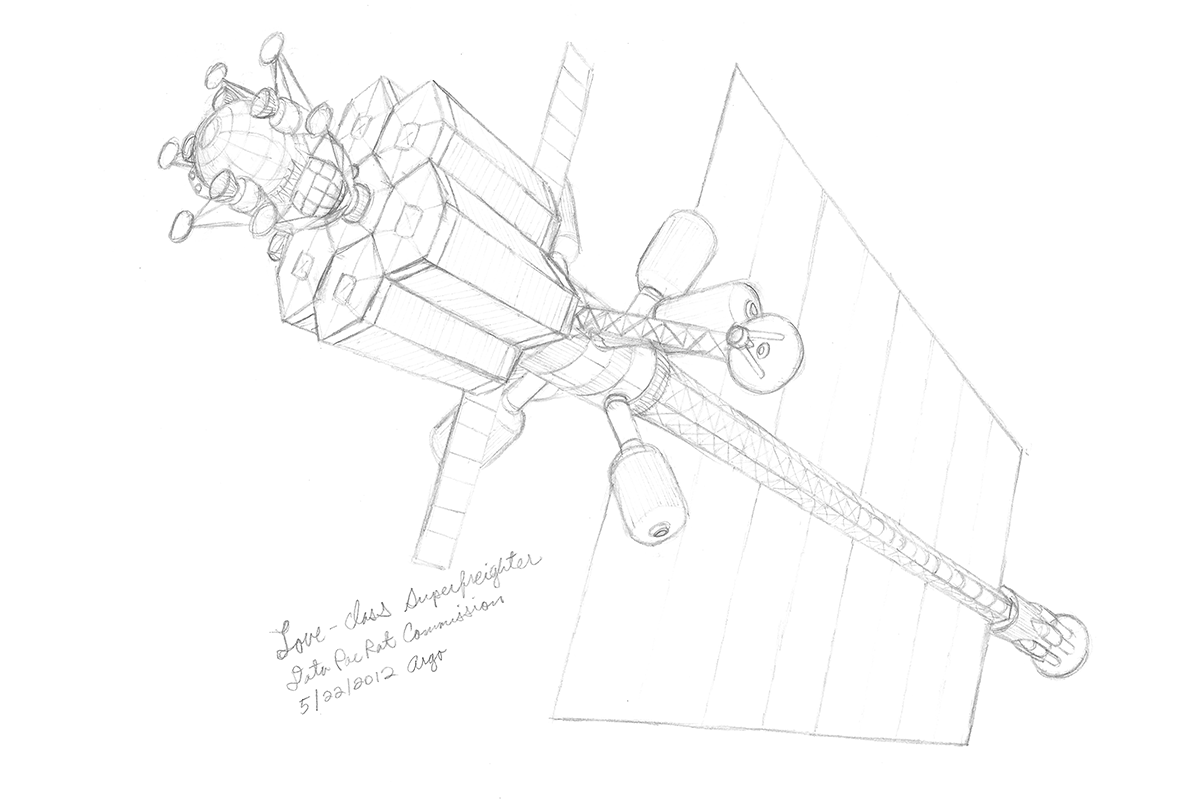
A small fleet of fuel tankers, each carrying multiple 40-tonne bags of water. The two main variations are the WN "Water Nymphs", nuclear-heated steam rockets to lift off from an asteroid or moon into orbit, and the WS "Waterslides" solar-powered steam rockets to carry them wherever needed. Both use engines of astonishingly low efficiency - Isp of 198 seconds - but due to the simplicity and low mass, turn out to be the most economical for the task. (Main inspiration: http://www.neofuel.com/solarship/.)
Anthony Zuppero has shown that this is the cheapest and most energy efficient means to move cargo, assuming unlimited water (as would be the case at an ET factory). The WS solar-heats water to 1100 K, by using inflatable mirrors.

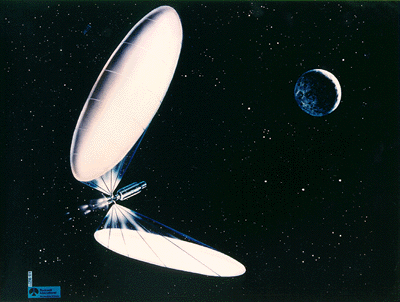
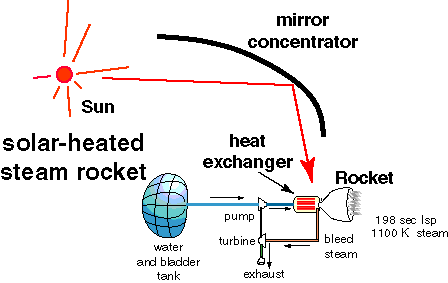
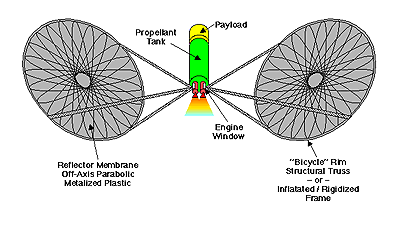
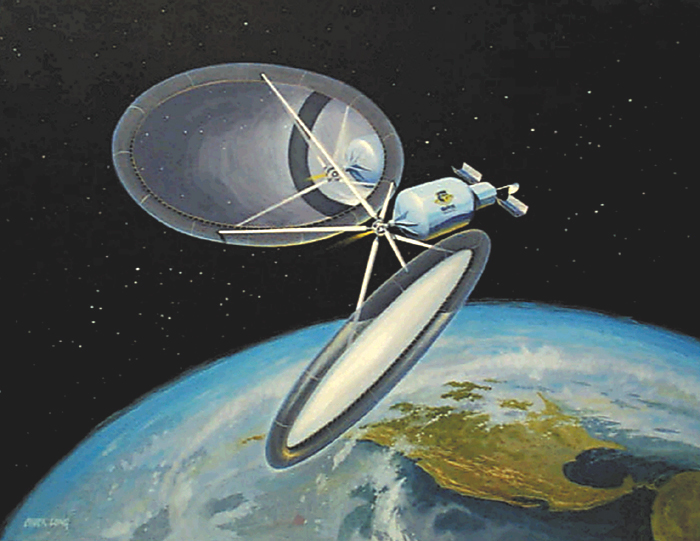
(Most text and images derived from "High Frontier", some derived from "Atomic Rockets", some from random web-searches.)